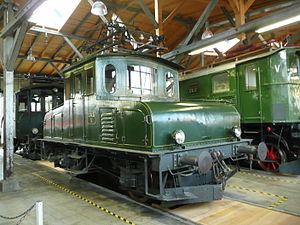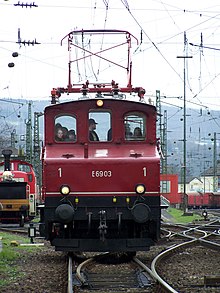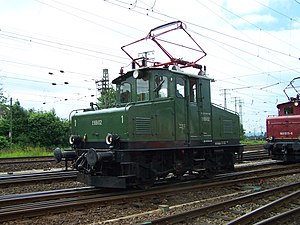LAG 1 to 5
| LAG 1–5 / DR series E 69 | |
|---|---|
|
E 69 03 + E 69 02 + E 69 05 at a vehicle parade at the DB Museum in Koblenz-Lützel, June 2012
|
|
| Number: | 5 |
| Axis formula : | Bo |
| Gauge : | 1435 mm ( standard gauge ) |
| Top speed: | 50 km / h |
| Driving wheel diameter: | 1000 mm |
| Power system : | 5.5 kV, 16 Hz ~; 5 kV, 16 2 ⁄ 3 Hz ~; 15 kV, 16 2 ⁄ 3 Hz ~ |
| Power transmission: | Overhead line |
| Number of traction motors: | 2 |
| Drive: | Pawbearing drive |
The five largely similar electric locomotives of the Lokalbahn Aktien-Gesellschaft (LAG) were designated as LAG 1 to 5 . After the nationalization of the LAG on August 1, 1938, the Deutsche Reichsbahn (DR) designated the locomotives as E 69 01–05.
Similarities
All five locomotives were procured by the LAG and used on the Ammergaubahn from Murnau to Oberammergau . This line was first electrified in 1904 with single-phase alternating current of 5.5 kV at a frequency of 16 Hz . Operations began with four electric railcars . Later, however, because of the simpler conversion from the public 50 Hz network, a changeover to 5 kV at 16 ⅔ Hz took place. When it was taken over in 1938, the DR included all locomotives as the E 69 series in its numbering system; at the LAG, the locomotives had both numbers and female first names. The German Federal Railroad (DB) converted the line in 1954/55 to its traction current system with 15 kV and 16 ⅔ Hz, which made a major conversion of the machines necessary.
Locomotive 1 "Katharina" (E 69 01)
| LAG 1 / E 69 01 | |
|---|---|
|
E 69 01 in the Freilassing locomotive world
|
|
| Year of construction (s): | 1905 |
| Retirement: | 1954 |
| Length over buffers: | 7500 mm |
| Service mass: | 23.5 t |
| Wheel set mass : | 11.8 t |
| Hourly output : | 206 kW |
| Continuous output : | 160 kW |
| Starting tractive effort: | 54 kN |
| Performance indicator: | 8.8 kW / t |
In 1905 the LAG procured an electric locomotive for 30,000 marks so that an extra steam locomotive no longer had to be kept for freight train service . The vehicle part came from the Katharinahütte machine factory in Rohrbach (Palatinate) (now Rohrbach ), the electrical equipment from Siemens-Schuckertwerke (SSW). This first single-phase alternating current locomotive in Germany was powered by two motors in a pawl bearing arrangement. The exterior corresponded to the appearance of the later shunting locomotives thanks to the driver's cab, which was arranged in the center and closed on all sides (a comfort that the steam locomotive staff had to wait a long time for) with the pantograph on the roof and two flat, forward and backward sloping stems . The pantograph with its two lyre-shaped brackets was erected by spring force and pulled in with a cable. In 1935 an extensive overhaul and some modifications took place in the LAG workshop. The DR equipped the machine with a standard pantograph. By 1954 the vehicle had covered around 1.5 million kilometers. When the line was converted to 15 kV at 16 ⅔ Hz, the engine would have had to be rebuilt, which seemed uneconomical with the almost 50-year-old locomotive. The E 69 01 was retired on November 25, 1954.
After the decommissioning, the locomotive came to the DB repair shop in Munich-Freimann , where it, including the original pantograph, was returned to the state of the LAG time. It stood for many years, well cared for, as a memorial in the plant's green spaces. Until 2006 it was exhibited as the first German single-phase AC locomotive in the Deutsches Museum in Munich. Since 2006 it has been in the Lokwelt Freilassing Museum in Freilassing with other locomotives relocated due to lack of space .
Locomotives 2 and 3 "Pauline" and "Hermine" (E 69 02-03)
| LAG 2 and 3 / E 69 02 and E 69 03 | |
|---|---|
|
E 69 02 in Koblenz-Lützel, June 2012
|
|
| Year of construction (s): | 1909 (E 69 02) 1912 (E 69 03) |
| Retirement: | 1982 |
| Length over buffers: | 7350 mm |
| Service mass: | 25.5 t |
| Wheel set mass : | 12.8 t |
| Hourly output : | 352 kW |
| Continuous output : | 306 kW |
| Starting tractive effort: | 82 kN |
| Performance indicator: | 13.8 kW / t |
As the volume of traffic on the route continued to increase, especially with a view to the Oberammergau Passion Play in 1910, additional locomotives had to be procured for use in front of passenger trains. LAG 2 was put into service in August 1909, supply companies were Krauss and SSW. Outwardly, it was very similar to LAG 1 and it also had the same pantograph, only the stems were a little higher to accommodate the much more powerful engines.
Just three years later, in 1912, the same suppliers supplied LAG 3, which was an almost identical replica of its predecessor. It differs from LAG 2 only in small details.
During a renovation in the LAG workshop in Murnau in 1938, almost all of the electrical equipment in LAG 2 was replaced in cooperation with the BBC . A BBC safety driving circuit was also installed. The same treatment was given to the E 69 03 in the Munich-Freimann AW in 1940 after it was taken over by the DR.
In 1949 both machines received traction motors from decommissioned electric railcars of the ET 31 series . The conversion of the line to the contact wire voltage of 15 kV, 16 ⅔ Hz made a renewed conversion necessary, which was carried out again in the AW München-Freimann. Facilities for shunting radio were also installed. In 1955 both locomotives were stationed in Heidelberg , where they were used as shifting locomotives . After nine years abroad, they returned to their regular Bavarian route in 1964, where they served until they were retired in 1982. The 169 002 was the oldest electric locomotive in the DB for many years.
In order to accommodate additional systems of the Indusi facilities, a side window had to be laminated on each side of the locomotive during the main inspections in 1977. On the E 69 02 the right window on page 1 and 2 (May 26, 1976) and on the E 69 03 the left (since the 1950s) and right side window (December 29, 1976) on page 1. They also differ the locomotives at the position of the handrails. On the E 69 02 these are above the stems and on the E 69 03 on the sides of the stems.
The locomotives were responsible for the traffic to Oberammergau until May 1981, 169 002 still drove a Gmp pair between Garmisch and Griesen in the following 1981 summer schedule , while 003 was used as a replacement locomotive for the last service, the freight train to Oberammergau (driven by 005). The last scheduled missions were on September 25, 1981 with 169 003 Murnau – Oberammergau – Murnau and on September 26, 1981 with 169 002 Garmisch – Giesen and back. Both locomotives will remain in service for special trains until June 29, 1982, when they were taken out of service.
Both locomotives still exist and are owned by the DB Museum , where they were optically refurbished and redrawn as E 69.
- The E 69 02 is located in vehicle hall 1 of the DB Museum Nuremberg. The locomotive is technically fully operational.
- The E 69 03 is operational and was on loan from the Bavarian Railway Museum in Nördlingen. Since March 2008 it has been in the DB Museum in Koblenz - Lützel with a deadline until 2026.
Locomotive 4 "Johanna" (E 69 04)
| LAG 4 / E 69 04 | |
|---|---|
|
E 69 04 in front of Murnau train station
|
|
| Year of construction (s): | 1922 |
| Retirement: | 1977 |
| Length over buffers: | 7750 mm |
| Service mass: | 25.6 t |
| Wheel set mass : | 12.8 t |
| Hourly output : | 268 kW |
| Continuous output : | 237 kW |
| Starting tractive effort: | 69 kN |
| Performance indicator: | 10.5 kW / t |
At the beginning of the 1920s, the LAG urgently needed a powerful freight locomotive for the Murnau – Oberammergau route. Siemens in Berlin delivered a two-axle locomotive with a very unconventional structure in 1922. It had the driver's cab at the end of the vehicle, in front of which there was a long, sloping porch on which the extended roof was supported with two stands. The mechanical part of the locomotive was created from half of the Siemens three-phase test locomotive, which was built in 1902 for the study society for the electrical rapid transit trains Marienfelde-Zossen . However, the electrical equipment with the two peg bearing motors was newly developed. The similar other half of the mentioned test locomotive gives an impression of the unusual visual appearance of the locomotive. This was used as a factory locomotive by the Siemens freight railway in Berlin until 1988 and is now in the German Museum of Technology in Berlin .
In 1934 Krauss-Maffei delivered a new body with a central driver's cab, which was largely similar to that of LAG 5. The electrical equipment remained unchanged until the renovation for the 15 kV network in 1955 in the Munich-Freimann AW. The locomotive was in service until it was taken out of service in 1977. It was fully functional because the locomotive was to serve as a spare parts dispenser for the more popular sister machine 169 003.
It was then set up in Munich on Arnulfstrasse in front of the Federal Railway Central Office . After the property was sold, the locomotive was erected as a memorial in front of the Murnau train station in 1997 . In 2013, the paint of the locomotive was renewed and the monument was supplemented by a historic contact line mast for the Murnau – Oberammergau railway line, including the overhead line. In the summer months, the locomotive can be viewed by the public on two Sundays per month
Locomotive 5 "Adolphine" (E 69 05)
| LAG 5 / E 69 05 | |
|---|---|
|
E 69 05 in Koblenz-Lützel
|
|
| Year of construction (s): | 1930 |
| Retirement: | 1981 |
| Length over buffers: | 8700 mm |
| Service mass: | 32.0 t |
| Wheel set mass : | 16.0 t |
| Hourly output : | 605 kW |
| Continuous output : | 565 kW |
| Starting tractive effort: | 93 kN |
| Performance indicator: | 18.9 kW / t |
As the last and by far the most powerful locomotive, the LAG procured No. 5 from Maffei and SSW for the transport of heavy freight trains in 1930 . Compared to the first four locomotives, the LAG 5 had much more powerful bearing motors and a longer axle base and was longer overall. The driver's cab was much more spacious; the resulting relatively short but high and only slightly beveled stems gave the machine a beefy appearance. The original pantograph with two contact strips was later exchanged for a standard pantograph. The vehicle was one of the very first electric locomotives to be delivered with a BBC safety driving circuit as standard. The E 69 05 was converted to 15 kV in the summer of 1953 at the Munich-Freimann AWS as the first locomotive of the series and returned to the Ammergaubahn immediately after the power system was changed in June 1954. Since then, it has mainly been used in freight train service together with the E 69 04, which it provided without any problems until it was retired in 1981.
The 169 005 has also been preserved and is owned by the Bavarian Local Railway Association . It is operational and was equipped in 2004 with PZB 90 for operation on DB tracks. According to a new investigation, it can remain in use until the mid-2020s.
literature
- Dieter Bäzold, Günther Fiebig: Electric locomotive archive . 6th edition. Transpress Verlag, Berlin 1987, ISBN 3-344-00173-6 .
- Bernd Mühlstrasser: The E 69 series - the Bavarian local electric locomotives and the Murnau – Oberammergau line . EK-Verlag, Freiburg 2005, ISBN 3-88255-169-0 .
- BSW Group for the Preservation of Historic Rail Vehicles Koblenz (Ed.): 100 Years E69 03 1912–2012 . 1st edition. DB Museum Koblenz, Koblenz 2012.
- Horst J. Obermayer: Paperback German electric locomotives . 7th edition. Franckh'sche Verlagshandlung, Stuttgart 1986, ISBN 3-440-03754-1 .
Web links
- LAG 1 to 5 in the model
- Bavarian Railway Museum Nördlingen
- Bayerischer Localbahnverein e. V.
- Website of 169 005
Individual evidence
- ↑ Railway operation and maintenance . In: Wilhelm Kübler (Hrsg.): Electric railways and operations . No. 27 . R. Oldenbourg, Berlin and Munich 1906, p. 519 f . ( archive.org [accessed November 1, 2018]).
- ↑ The Siemens freight railway with a picture of the locomotive ( memento of the original from July 25, 2010 in the Internet Archive ) Info: The archive link has been inserted automatically and has not yet been checked. Please check the original and archive link according to the instructions and then remove this notice. at epilog.de. Retrieved June 26, 2010.
- ^ Illustration of the locomotive in the museum from April 2007. Accessed on June 26, 2010.
- ^ Ralf Roman Rossberg : reasons to celebrate. In: eisenbahn-magazin 12/2013, p. 32
- ↑ Roland Scheller: The "five" from the Ammertal. E 69 05 - prototype and model. In: Eisenbahn-Kurier , Issue 7/2016, EK-Verlag GmbH, Freiburg, pp. 42–47, ISSN 0170-5288





